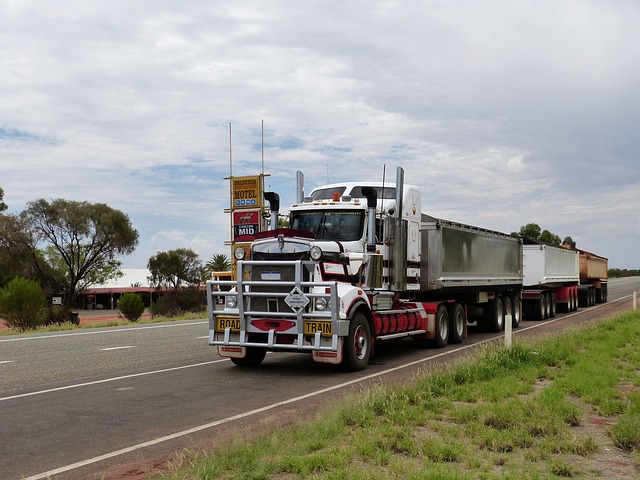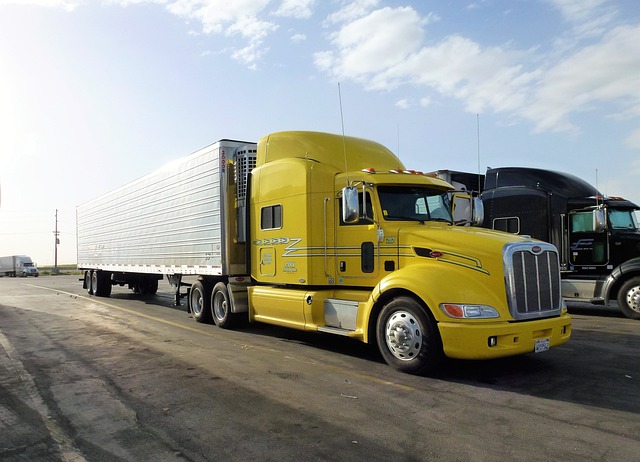When selecting and installing a new truck battery, it's crucial to ensure it matches your vehicle's electrical system demands and complements your driving habits and additional features like GPS or extra lighting. The chosen battery must withstand the weather extremes of your region, particularly for cold cranking amps (CCA) needed in colder climates, and have sufficient reserve capacity (RC) for auxiliary systems. Safety is a priority throughout the installation process; prepare by having essential tools on hand, work in a well-ventilated area, and ensure the vehicle is stable before starting. Disconnect the old battery cables and clean the battery terminals to prevent corrosion. Position the new truck battery correctly within its tray, secure it, and reconnect the cables in the right order—negative then positive—ensuring a snug fit without over-tightening. After installation, conduct thorough tests of your truck's electrical system, including starting the engine and checking all components for proper function. Use a multimeter to verify battery voltage at different stages to confirm it holds a good charge. Regular monitoring post-installation is necessary to ensure the new battery delivers optimal performance across various driving conditions.
Navigating the intricacies of vehicle maintenance, a well-functioning truck battery is pivotal for your vehicle’s performance. This step-by-step guide empowers you with the knowledge to install a new truck battery with confidence and precision. From assessing your truck’s specific battery needs to safely removing the old one and meticulously installing the new, each stage is outlined to ensure a seamless process. With a focus on safety and efficiency, this article provides an in-depth look at each critical step involved in maintaining your truck’s electrical integrity, ensuring you stay powered on every journey.
- Understanding Your Truck's Battery Needs
- Preparing for Battery Installation: Safety First
- Gathering Necessary Tools and Materials for the Job
- Removing the Old Truck Battery Safely
- Inspecting the Battery Tray and Connections
- Installing the New Truck Battery with Precision
- Finalizing the Installation and Testing Your Truck's Electrical System
Understanding Your Truck's Battery Needs

When addressing your truck’s battery needs, it’s crucial to consider the specific requirements of your vehicle’s electrical system and the nature of your truck’s usage. A truck battery’s performance is influenced by factors such as climate, driving habits, and the truck’s features. For instance, if your truck is equipped with accessories like a GPS, radio, or lighting that draws significant power, you’ll need a battery capable of handling these demands without failing. Additionally, consider the ambient temperature where you operate your vehicle; extreme heat or cold can affect battery life and performance. Opt for a battery that’s rated for your climate zone to ensure optimal operation. Always refer to your truck’s manual for recommended battery types and capacities. When selecting a new battery, look for one that matches or exceeds the cold cranking amps (CCA) and reserve capacity (RC) specified by the manufacturer. These ratings indicate the battery’s ability to start the engine in cold conditions and its reserve power to run auxiliary systems without being recharged, respectively. Proper installation follows correct selection; ensure you have the right tools and a safe workspace before beginning. Remove the old battery carefully, noting how it was positioned and connected for reference during installation of the new unit. Secure the new truck battery in place, ensuring it’s firmly mounted to prevent movement that could damage the battery or its connections. Connect the battery cables, first attaching the negative (-) cable to the negative terminal on the battery, then the positive (+) cable to the positive terminal, tightening all connections securely. Always follow safety protocols, including disconnecting the vehicle’s electrical system if necessary, to prevent short circuits or electrical surges that could harm both the battery and your truck’s electronic components. By understanding your truck’s battery needs and following a systematic approach to installation, you can ensure a long-lasting and reliable power source for your vehicle.
Preparing for Battery Installation: Safety First

Prior to embarking on the installation of your new truck battery, it is imperative to approach the task with safety as your top priority. Begin by thoroughly reading the vehicle’s owner manual for specific instructions related to your truck’s make and model. This will ensure you are fully aware of any unique considerations or warnings associated with your vehicle. Ensure that you have all the necessary tools and equipment at hand, including a battery wrench, safety glasses, gloves, and a clean cloth. Work in a well-ventilated area to avoid inhaling any hazardous fumes that may be released during the process.
Once prepared, proceed by safely securing the truck and ensuring it is parked on a level surface. Engage the parking brake and turn off the vehicle’s electrical system to prevent any potential electrical surges. Disconnect the negative (black) battery cable first to discharge the battery and minimize the risk of electric shock. With the cable disconnected, you can now safely remove the old battery. Clean the terminals and mounting area where the new truck battery will be installed. When handling the new battery, take care not to bend or damage the casing. After placing the new battery in position, secure it properly according to the manufacturer’s instructions, making sure it is not overly tightened as this can damage the battery casing. Finally, reconnect the negative cable first, followed by the positive (red) cable, and start the engine to ensure everything is functioning correctly. Always remember to recycle your old battery responsibly.
Gathering Necessary Tools and Materials for the Job

When embarking on the task of installing a truck battery, preparation is key to ensure a smooth and efficient process. To begin with, you’ll need to gather the necessary tools and materials that will facilitate the job. A set of sturdy gloves and safety glasses are essential for personal protection, as working with batteries can be hazardous if proper precautions aren’t taken. Next, locate a reliable battery with the correct specifications for your truck model. A multimeter is crucial for testing the voltage of the new battery upon installation to ensure it holds a charge effectively.
In addition to safety gear and diagnostic tools, you’ll need a few more items to complete the task successfully. A wrench or socket set in the appropriate size is necessary for disconnecting the old battery and connecting the new one. Cable ties or clamps might be needed to organize and secure battery cables, preventing any potential shorts or rattling. A clean cloth or battery terminal cleaner will aid in cleaning corroded terminals on both the battery and the vehicle’s chassis, ensuring a good electrical connection. Lastly, have an old rag or absorbent material ready to neutralize any acid spills from the old battery. With all these tools and materials at hand, you are well-equipped to tackle the installation of your truck’s battery safely and effectively.
Removing the Old Truck Battery Safely

Before installing a new truck battery, it’s crucial to handle the removal of the old one safely and efficiently. Begin by ensuring that your vehicle is parked on a level surface and that the engine is turned off to prevent any electrical shorts or accidents while working. It’s essential to disconnect the negative battery cable first, using a wrench to loosen it from the battery terminal. Once disconnected, secure the cable away from the battery to avoid inadvertent reconnections. Next, remove any mounting bolts or hold-down clamps that secure the battery in place. These are typically located on the bottom of the battery; after removing them, support the battery as you lift it out to prevent spilling any corrosive electrolyte. Be mindful of the battery’s weight and handle it with care to avoid injury. Once the old battery is removed, clean the battery tray where the new battery will be installed, ensuring there’s no debris or residue that could cause a short circuit or interfere with proper installation. Proper ventilation is key during this process due to the hazardous materials in the battery, so always work in a well-ventilated area and consider wearing protective gloves and eyewear. By taking these precautions, you’ll ensure a safe removal of your old truck battery, paving the way for a smooth installation of a new one.
Inspecting the Battery Tray and Connections

When installing a new truck battery, safety and precision are paramount. Begin by thoroughly inspecting the battery tray to ensure it is securely fastened and free from damage or corrosion. The battery tray supports the battery and prevents unwanted movement during operation, which can lead to potential shorts or excessive wear on the battery terminals. It’s crucial to clean any existing corrosion from the battery terminals and the tray contacts before installation. Use a mixture of baking soda and water to gently scrub the connections with a soft brush, then rinse thoroughly with water and dry with a clean cloth. This ensures good electrical contact and optimal performance from your truck battery.
Once the tray and connections are cleaned and inspected, proceed to place the new battery in position. Make sure the battery is correctly aligned within the tray. The positive and negative terminals should align with their respective posts on the tray. Secure the battery with the hold-down clamp or strap, tightening it enough to prevent the battery from moving but not so much as to damage the battery case. Double-check all connections: the positive terminal should connect to the positive post, and the negative terminal to the grounding point, which is often found on the engine or chassis. Properly connecting your truck battery will guarantee a safe and reliable power source for all your truck’s electrical needs.
Installing the New Truck Battery with Precision

When installing a new truck battery, precision and attention to detail are paramount to ensure optimal performance and longevity. Begin by safely and securely positioning your vehicle on a level surface with the wheels chocked to prevent any unwanted movement during the installation process. Always start by disconnecting the existing battery; this can typically be done by removing the negative (black) cable first, followed by the positive (red) cable, to avoid any electrical shorts or shocks. Once the cables are removed, clean and inspect the terminals on your truck’s battery tray for corrosion or damage and replace them if necessary. This ensures a solid electrical connection with the new battery.
Proceed to place the new truck battery in position, ensuring it is correctly aligned within the battery tray. The battery should be installed with the correct orientation as indicated by the manufacturer; improper installation can lead to reduced efficiency or damage to the battery and vehicle systems. Once in place, secure the battery with the retaining strap, tightening it according to the manufacturer’s specifications but not so tightly that you risk damaging the battery case. After securing the new battery, reconnect the cables, starting with the positive terminal, and ensure they are firmly attached without over-tightening. Finally, check all electrical connections for tightness, verify the battery is holding a charge, and test your truck’s electrical systems to confirm everything is functioning as intended. Proper installation of a new truck battery can significantly enhance your vehicle’s performance and reliability.
Finalizing the Installation and Testing Your Truck's Electrical System

After securing the truck battery in place and connecting the necessary cables, the final step is to properly fasten all components. It’s crucial to ensure that the battery is held firmly to prevent any movement that could cause damage or disconnection during operation. Once the battery is securely mounted, reconnect the negative (-) terminal first, then the positive (+) terminal, adhering strictly to the correct polarity as indicated by your vehicle’s manual. Proper cable management should be observed to avoid any potential shorts or friction that could lead to overheating or damage.
With the battery installation complete, it’s imperative to test your truck’s electrical system thoroughly. Start the engine to verify that it cranks smoothly and that all electrical components, including lights, radio, and other accessories, function correctly. Check for any signs of improper connections or issues with the alternator charging the battery. Utilize a multimeter to measure the voltage of the battery while the vehicle is off, during cranking, and after the engine has been running for some time to ensure it holds and receives charge as expected. Additionally, monitor the battery’s performance over the next few days or even weeks to confirm its health and reliability under different driving conditions. If all readings are within the specified ranges and there are no electrical glitches, your truck’s electrical system should be functioning optimally with your new battery in place.
When addressing the replacement of your truck’s battery, it is imperative to follow a detailed, step-by-step guide to ensure safety and proper function. This article has outlined each essential step, from understanding your truck’s specific battery requirements to the precise installation of the new unit. By preparing with the right tools and adhering to safety protocols, you can confidently remove the old battery, inspect the tray and connections for corrosion or damage, and install the new truck battery correctly. Remember to conduct a final test of your truck’s electrical system to confirm everything is functioning as intended. With these steps in mind, you’ll have a reliable power source that keeps your truck running smoothly.



